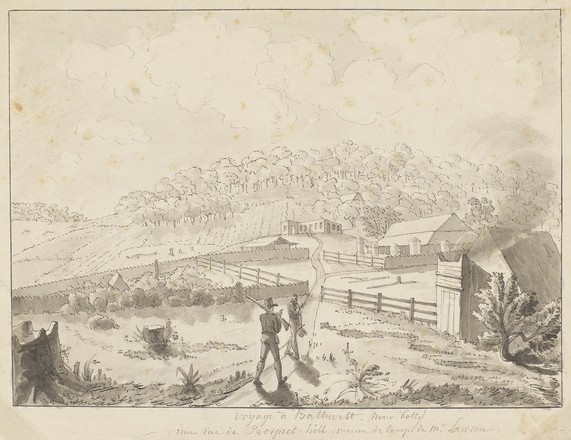‘Voyage à Bathurst (nouv. holl.), Une vue de Prospect Hill, Maison de Camp de M. Lawson’, 1819
Wash drawing
SV / 302
Purchased
March 2015
This small
landscape painting of Prospect Hill (now the suburb of Pemulwuy), NSW, shows
the rural estate of soldier, surveyor, explorer and pastoralist, William Lawson
(1774-1850). Situated 30 kilometres west of central Sydney and about 8
kilometres west of Parramatta, the view shows Lawson’s property during
transition. Construction of a new mansion house Veteran’s Hall was underway, replacing an earlier house of 1810.
Painting of Prospect Hill
By Margot Riley
This small
landscape painting of Prospect Hill (now the suburb of Pemulwuy), NSW, shows
the rural estate of soldier, surveyor, explorer and pastoralist, William Lawson
(1774-1850). Situated 30 kilometres west of central Sydney and about 8
kilometres west of Parramatta, the view shows Lawson’s property during
transition. Construction of a new mansion house Veteran’s Hall was underway, replacing an earlier house of 1810,
though the roofless structure at the centre of the image could be either
dwelling. The property was demolished the 1920s and is now largely covered by
the Prospect Reservoir.
The fifth recorded crossing of the Blue Mountains by Europeans
By Margot Riley
A dated
inscription on this work places its creation in the final weeks of 1819, when
the French corvette Uranie brought
Louis de Freycinet’s expedition of scientific discovery (1817-1820) to Sydney
for five weeks. Towards the end of November, midshipman and naval draughtsman
J. Alphonse Pellion (1776-1868), with two fellow Frenchmen, a couple of
indigenous guides and a sailor as interpreter, travelled to Bathurst via the
newly completed Cox’s Road, making only the fifth recorded crossing of the Blue
Mountains by Europeans.
Governor
Macquarie had instructed William Lawson, recently appointed Commandant of
Bathurst, to accompany the visitors on their regional tour and facilitate their
scientific researches; the party spent the first night of their twelve day
excursion at the Lawson estate. Naturalist Gaudichaud-Beaupre described the
moist and marshy soil of Lawson’s property as ‘so abundant in alumide
(aluminium oxide)’ that ‘nothing more is necessary but to form the earth into
masses of a proper shape and burn these to produce bricks...sufficiently
substantial for building; to which use they are daily applied’. It is, perhaps,
just such a brick manufactory that appears – as a row of five tallish beehive ovens
– in the mid-foreground on the right of Pellion’s view of Prospect Hill.
Pellion’s
suite of NSW drawings – grouped under the title ‘Voyage à Bathurst’ and of
which ‘Une vue de Prospect Hill’ appears to be the first – were all taken from
nature, drawn on the spot and completed within days or weeks of each other.
These works were then returned to France where they remained in the collection
of Claude, Baron de Saulces de Freycinet (great great-grand-nephew of Louis de
Freycinet) until the early 1960s.



 Back to list
Back to list